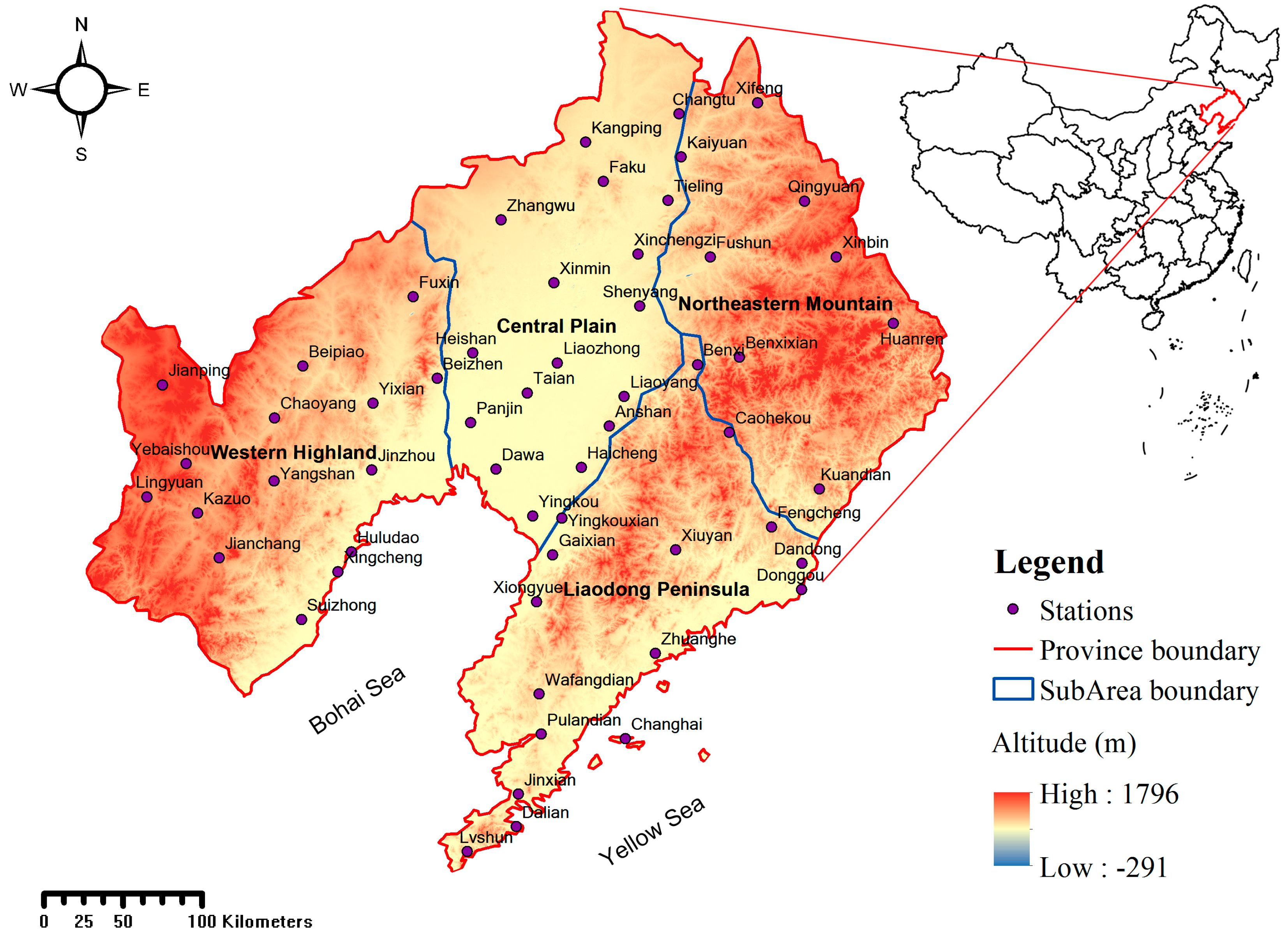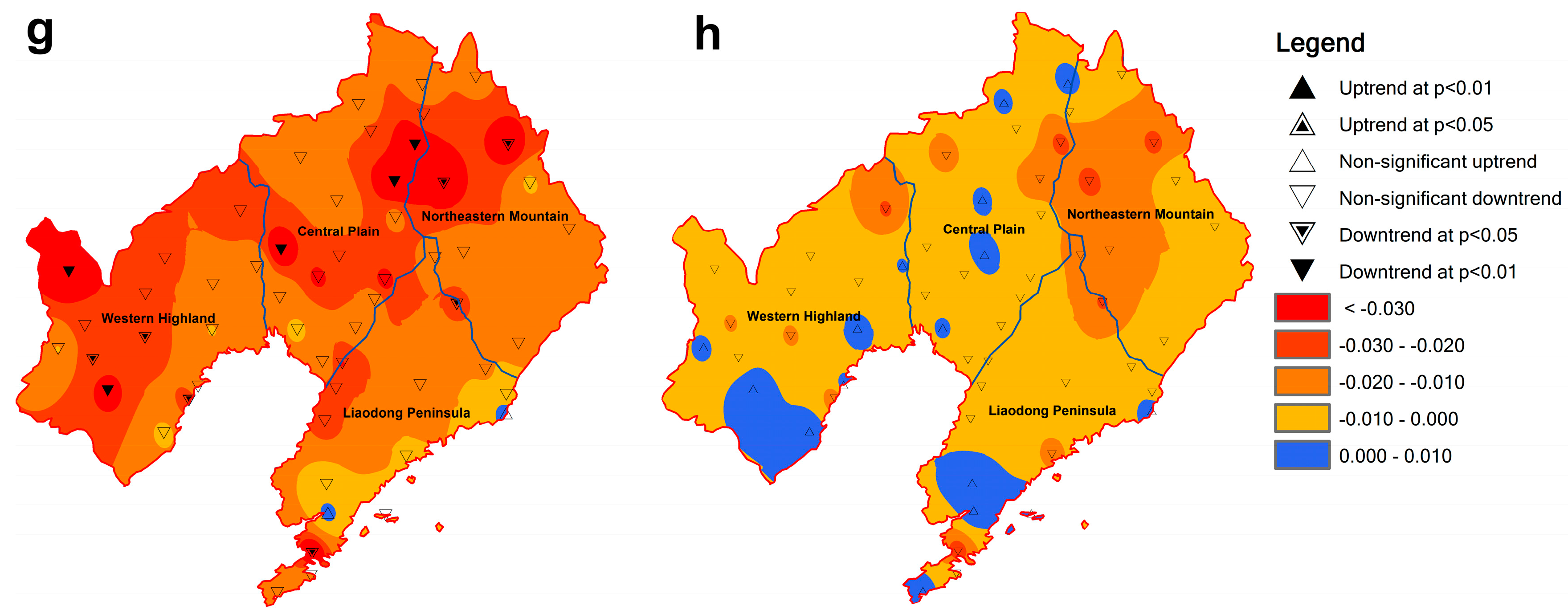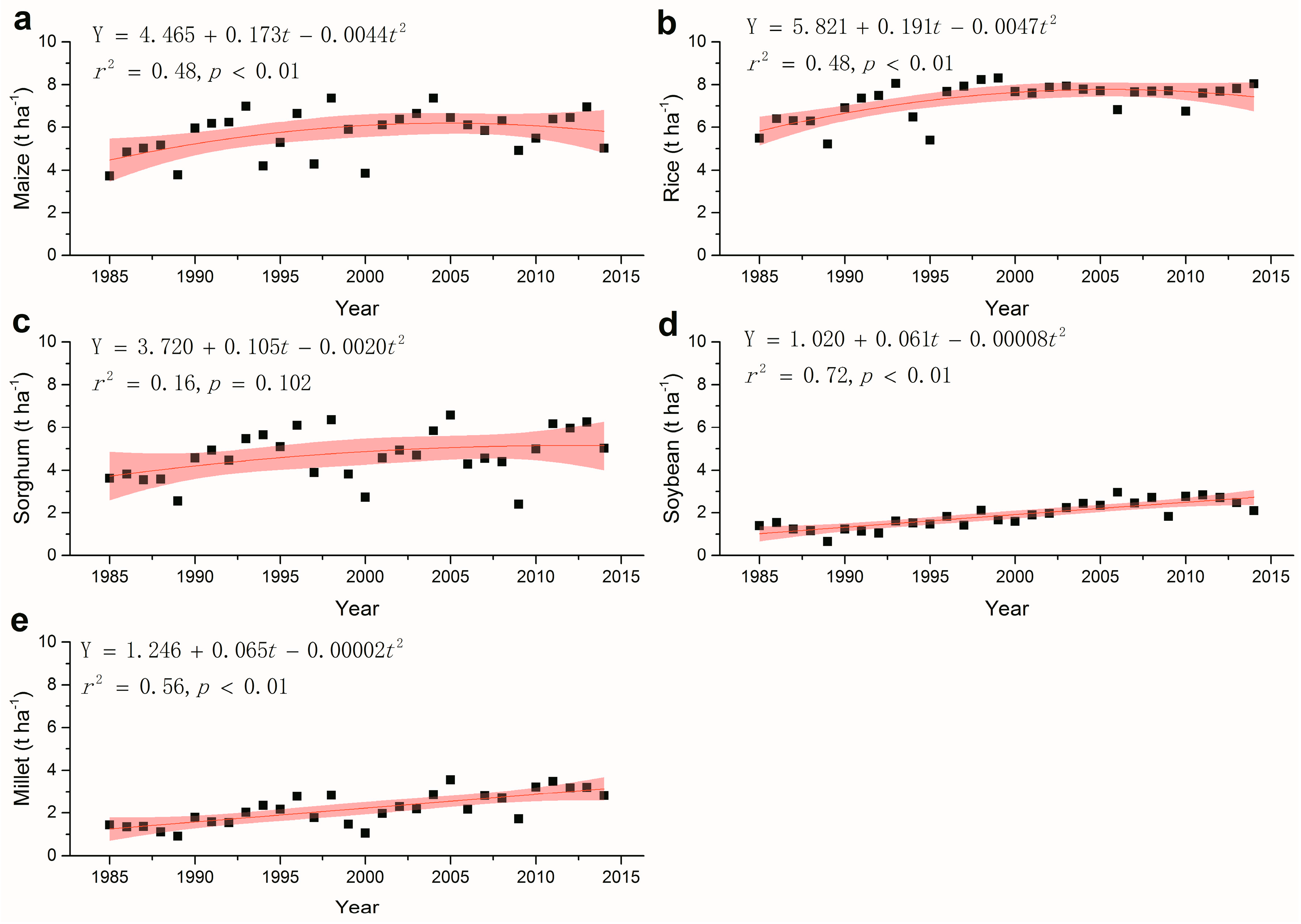Assessment of Drought Impact on Main Cereal Crops Using a Standardized Precipitation Evapotranspiration Index in Liaoning Province, China
Abstract
:1. Introduction
2. Materials and Methods
2.1. Study Region
2.2. Meteorological Data and Drought Identification
2.3. Trend Analysis
2.4. Yield Data
3. Results
3.1. Temporal and Spatial Variability of Monthly Precipitation, ET0, and SPEI
3.2. Spatiotemporal Variability of Drought
3.3. Long-Term Fluctuation of the Main Cereal Crop Yields
3.4. Drought Impact on the Main Cereal Crop Yields
3.5. Contribution of Drought to Yield Losses for Rainfed Cereal Crops
4. Discussion
5. Conclusions
Acknowledgments
Author Contributions
Conflicts of Interest
References
- Intergovernmental Panel on Climate Change (IPCC). Climate Change 2013. The Physical Science Basis. Working Group I Contribution to the Fifth Assessment Report of the Intergovernmental Panel on Climate Change; Cambridge University Press: Cambridge, UK, 2013. [Google Scholar]
- Potop, V.; Možný, M. The Application a New Drought Index-Standardized Precipitation Evapotranspiration Index in the Czech Republic. Available online: http://www.cbks.cz/SbornikSMlyn11/Potop1.pdf (assessed on 8 October 2016).
- Yang, M.; Yan, D.; Yu, Y.; Yang, Z. SPEI-based spatiotemporal analysis of drought in haihe river basin from 1961 to 2010. Adv. Meteorol. 2016, 2016, 7658015. [Google Scholar] [CrossRef]
- Grayson, M. Agriculture and drought. Nature 2013, 501, S1. [Google Scholar] [CrossRef] [PubMed]
- Zhang, Q.; Zhang, J. Drought hazard assessment in typical corn cultivated areas of China at present and potential climate change. Nat. Hazards 2016, 81, 1323–1331. [Google Scholar] [CrossRef]
- Chen, Z.; He, X.; Cook, E.R.; He, H.-S.; Chen, W.; Sun, Y.; Cui, M. Detecting dryness and wetness signals from tree-rings in Shenyang, Northeast China. Palaeogeogr. Palaeoclimatol. Palaeoecol. 2011, 302, 301–310. [Google Scholar] [CrossRef]
- Wang, A.; Lettenmaier, D.P.; Sheffield, J. Soil moisture drought in China, 1950–2006. J. Clim. 2011, 24, 3257–3271. [Google Scholar] [CrossRef]
- Yu, X.; He, X.; Zheng, H.; Guo, R.; Ren, Z.; Zhang, D.; Lin, J. Spatial and temporal analysis of drought risk during the crop-growing season over northeast China. Nat. Hazards 2013, 71, 275–289. [Google Scholar] [CrossRef]
- Palmer, W. Meteorological Drought; Research Paper No. 45. Available online: https://www.ncdc.noaa.gov/temp-and-precip/drought/docs/palmer.pdf (assessed on 8 October 2016).
- Mckee, T.B.; Doesken, N.J.; Kleist, J. The relationship of drought frequency and duration to time scales. In Proceedings of the 8th Conference on Applied Climatology, Zurich, Switzerland, 13–17 September 2010; Volume 17, pp. 179–183.
- Quiring, S.M.; Ganesh, S. Evaluating the utility of the Vegetation Condition Index (VCI) for monitoring meteorological drought in Texas. Agric. For. Meteorol. 2010, 150, 330–339. [Google Scholar] [CrossRef]
- Vicente-Serrano, S.M.; Beguería, S. Comment on ‘Candidate distributions for climatological drought indices (SPI and SPEI)’ by James H. Stagge et al. Int. J. Climatol. 2016, 36, 2120–2131. [Google Scholar] [CrossRef]
- Vicente-Serrano, S.M.; Beguería, S.; López-Moreno, J.I. A multiscalar drought index sensitive to global warming: The standardized precipitation evapotranspiration index. J. Clim. 2010, 23, 1696–1718. [Google Scholar] [CrossRef]
- Park, S.; Im, J.; Jang, E.; Rhee, J. Drought assessment and monitoring through blending of multi-sensor indices using machine learning approaches for different climate regions. Agric. For. Meteorol. 2016, 216, 157–169. [Google Scholar] [CrossRef]
- Li, B.; Liang, Z.; Yu, Z.; Acharya, K. Evaluation of drought and wetness episodes in a cold region (Northeast China) since 1898 with different drought indices. Nat. Hazards 2013, 71, 2063–2085. [Google Scholar] [CrossRef]
- World Meteorological Organization (WMO). Standardized Precipitation Index User Guide; Svoboda, M., Hayes, M., Wood, D., Eds.; World Meteorological Organization: Geneva, Switzerland, 2012; p. 16. [Google Scholar]
- Potopová, V.; Boroneanţ, C.; Boincean, B.; Soukup, J. Impact of agricultural drought on main crop yields in the Republic of Moldova. Int. J. Climatol. 2016, 36, 2063–2082. [Google Scholar] [CrossRef]
- Wang, H.; Vicente-serrano, S.M.; Tao, F.; Zhang, X.; Wang, P.; Zhang, C.; Chen, Y.; Zhu, D.; Kenawy, A. Monitoring winter wheat drought threat in Northern China using multiple climate-based drought indices and soil moisture during 2000–2013. Agric. For. Meteorol. 2016, 228, 1–12. [Google Scholar] [CrossRef]
- Gerten, D.; Rost, S.; von Bloh, W.; Lucht, W. Causes of change in 20th century global river discharge. Geophys. Res. Lett. 2008, 35. [Google Scholar] [CrossRef]
- Kong, Q.; Ge, Q.; Zheng, J.; Xi, J. Prolonged dry episodes over Northeast China during the period 1961–2012. Theor. Appl. Climatol. 2014, 122, 711–719. [Google Scholar] [CrossRef]
- Yin, X.; Olesen, J.E.; Wang, M.; Kersebaum, K.-C.; Chen, H.; Baby, S.; Öztürk, I.; Chen, F. Adapting maize production to drought in the Northeast Farming Region of China. Eur. J. Agron. 2016, 77, 47–58. [Google Scholar] [CrossRef]
- Gao, Z.; He, J.; Dong, K.; Bian, X.; Li, X. Sensitivity study of reference crop evapotranspiration during growing season in the West Liao River basin, China. Theor. Appl. Climatol. 2016, 124, 865–881. [Google Scholar] [CrossRef]
- Li, W.-G.; Yi, X.; Hou, M.-T.; Chen, H.-L.; Chen, Z.-L. Standardized precipitation evapotranspiration index shows drought trends in China. Chin. J. Eco-Agric. 2012, 20, 643–649. [Google Scholar] [CrossRef]
- Leeming, F.A. Liaoning. Available online: http://www.britannica.com/EBchecked/topic/338861/Liaoning (accessed on 1 May 2016).
- Liu, D.; Guo, S.; Chen, X.; Shao, Q. Analysis of trends of annual and seasonal precipitation from 1956 to 2000 in Guangdong Province, China. Hydrol. Sci. J. 2012, 57, 358–369. [Google Scholar] [CrossRef]
- Allen, R.G.; Pereira, L.S.; Raes, D.; Smith, M. Crop Evapotranspiration-Guidelines for Computing Crop Water Requirements—FAO Irrigation and Drainage Paper 56; Food and Agriculture Organization of the United Nations: Rome, Italy, 1998. [Google Scholar]
- Beguería, S.; Vicente-Serrano, S.M. SPEI: Calculation of the Standardised Precipitation-Evapotranspiration Index. Available online: https://CRAN.R-project.org/package=SPEI (accessed on 1 May 2016).
- Yevjevich, V.M. An Objective Approach to Definitions and Investigations of Continental Hydrologic Droughts; Hydrology Papers No. 23; Colorado State University: Fort Collins, CO, USA, 1967. [Google Scholar]
- Rawat, K.S.; Tripathi, V.K. Standardized precipitation index based approach for development of regional drought monitoring system. J. Remote Sens. Technol. 2016, 4, 48–57. [Google Scholar] [CrossRef]
- Vicente-Serrano, S.M.; López-Moreno, J.I.; Drumond, A.; Gimeno, L.; Nieto, R.; Morán-Tejeda, E.; Lorenzo-Lacruz, J.; Beguería, S.; Zabalza, J. Effects of warming processes on droughts and water resources in the NW Iberian-Peninsula (1930–2006). Clim. Res. 2011, 48, 203–212. [Google Scholar] [CrossRef]
- Yue, S.; Pilon, P.; Phinney, B.; Cavadias, G. The influence of autocorrelation on the ability to detect trend in hydrological series. Hydrol. Process. 2002, 16, 1807–1829. [Google Scholar] [CrossRef]
- Sen, P.K. Estimates of the regression coefficient based on Kendall’s Tau. J. Am. Stat. Assoc. 1968, 63, 1379–1389. [Google Scholar] [CrossRef]
- Theil, H. A Rank-Invariant Method of Linear and Polynomial Regression Analysis. Available online: http://www.nrc.gov/docs/ML1330/ML13304B779.pdf (assessed on 8 October 2016).
- Marchetto, A. rkt: Mann-Kendall Test, Seasonal and Regional Kendall Tests. Available online: https://CRAN.R-project.org/package=rkt (accessed on 6 March 2016).
- Liaoning Statistics Bureau. Liaoning Statistical Yearbook 2014; China Statistics Press: Beijing, China, 2015. (In Chinese) [Google Scholar]
- Lobell, D.B.; Asner, G.P. Climate and management contributions to recent trends in US agricultural yields. Science 2003, 299, 1–17. [Google Scholar] [CrossRef] [PubMed]
- Wu, H.; Hubbard, K.G.; Wilhite, D.A. An agricultural drought risk-assessment model for corn and soybeans. Int. J. Climatol. 2004, 24, 723–741. [Google Scholar] [CrossRef]
- Feng, J.; Wu, J. Drought disaster situation in China and the main strategy for reducing drought risk. J. Catastrophol. 2008, 23, 34–36. [Google Scholar]
- Das, P.K.; Dutta, D.; Sharma, J.R.; Dadhwal, V.K. Trends and behaviour of meteorological drought (1901–2008) over Indian region using standardized precipitation-evapotranspiration index. Int. J. Climatol. 2016, 36, 909–916. [Google Scholar] [CrossRef]
- Li, H.; Yao, F.-M.; Zhang, J.-H.; Hao, C. Analysis on climatic maize yield and its sensitivity to climate change in Northeast China. Chin. J. Agrometeorol. 2014, 35, 423–428. [Google Scholar]
- Liu, X.; Zhang, X.; Wang, Y.; Sui, Y.; Zhang, S.; Herbert, S.; Ding, G. Soil degradation: A problem threatening the sustainable development of agriculture in Northeast China. Plant Soil Environ. 2010, 56, 87–97. [Google Scholar]
- Panu, U.S.; Sharma, T.C. Challenges in drought research: Some perspectives and future directions. Hydrol. Sci. J. 2002, 47, S19–S30. [Google Scholar] [CrossRef]
- Liu, Z.; Zhang, G.; Yang, P. Geographical variation of climate change impact on rice yield in the rice-cropping areas of Northeast China during 1980–2008. Sustainability 2016, 8, 670. [Google Scholar] [CrossRef]
- Vicente-Serrano, S.M.; Beguería, S.; Lorenzolacruz, J.; Camarero, J.J.; Lópezmoreno, J.I.; Azorinmolina, C.; Revuelto, J.; Morántejeda, E.; Sanchezlorenzo, A. Performance of drought indices for ecological, agricultural, and hydrological applications. Earth Interact. 2012, 16, 1–27. [Google Scholar] [CrossRef]
- Zhang, S.J.; Zhang, Y.S.; Sui, D.; Cai, F.; Jin-Wen, W.U.; Rui-Peng, J.I.; Chen, P.S.; Liu, Q.W. Changes in reference evapotranspiration and its causes in Northeast China. J. Nat. Resour. 2010, 25, 1750–1761. [Google Scholar]
- Mcvicar, T.R.; Roderick, M.L.; Donohue, R.J.; Li, L.T.; Niel, T.G.V.; Thomas, A.; Grieser, J.; Jhajharia, D.; Himri, Y.; Mahowald, N.M. Global review and synthesis of trends in observed terrestrial near-surface wind speeds: Implications for evaporation. J. Hydrol. 2012, 416–417, 182–205. [Google Scholar] [CrossRef]
- Mishra, A.K.; Singh, V.P. Drought modeling—A review. J. Hydrol. 2011, 403, 157–175. [Google Scholar] [CrossRef]
- Bannayan, M.; Sanjani, S.; Alizadeh, A.; Lotfabadi, S.S.; Mohamadian, A. Association between climate indices, aridity index, and rainfed crop yield in northeast of Iran. Field Crops Res. 2010, 118, 105–114. [Google Scholar] [CrossRef]
- China Meteorological Administration (CMA). Global Warming as a Driver Significantly Accelerates Northeast Grain Crops Extending to the North. Available online: http://www.weather.com.cn/climate/2013/07/qhbhyw/1927592.shtml (accessed on 4 July 2014).
- Xu, X.; Ge, Q.; Zheng, J.; Dai, E.; Zhang, X.; He, S.; Liu, G. Agricultural drought risk analysis based on three main crops in prefecture-level cities in the monsoon region of east China. Nat. Hazards 2013, 66, 1257–1272. [Google Scholar] [CrossRef]
- Bouman, B.A.M.; Humphreys, E.; Tuong, T.P.; Barker, R. Rice and water. Adv. Agron. 2007, 92, 187–237. [Google Scholar]







| Month | Maize | Rice | Sorghum | Soybeans | Millet |
|---|---|---|---|---|---|
| SPI-1 | |||||
| April | 0.28 | 0.09 | −0.07 | 0.29 | 0 |
| May | −0.24 | −0.34 | 0.17 | 0.05 | 0.39 * |
| June | 0.45 * | 0.01 | 0.36 | 0.2 | 0.23 |
| July | 0.36 | −0.24 | 0.52 ** | 0.31 | 0.51 ** |
| August | −0.1 | −0.23 | 0.33 | 0.57 ** | 0.50 ** |
| September | 0.15 | 0.04 | 0.21 | 0.02 | 0.18 |
| October | −0.02 | −0.16 | −0.05 | −0.01 | −0.11 |
| SPEI-1 | |||||
| April | 0.07 | 0.00 | −0.14 | 0.17 | −0.08 |
| May | −0.15 | −0.26 | 0.19 | 0.19 | 0.42 * |
| June | 0.47 * | −0.03 | 0.37 * | 0.29 | 0.28 |
| July | 0.27 | −0.32 | 0.54 ** | 0.30 | 0.56 ** |
| August | −0.18 | −0.21 | 0.36 | 0.51 ** | 0.53 ** |
| September | 0.02 | −0.21 | 0.15 | 0.10 | 0.20 |
| October | −0.04 | −0.13 | −0.03 | −0.08 | −0.11 |
| Month | Maize | Rice | Sorghum | Soybean | Millet | |||||
|---|---|---|---|---|---|---|---|---|---|---|
| SPI-1 | SPEI-1 | SPI-1 | SPEI-1 | SPI-1 | SPEI-1 | SPI-1 | SPEI-1 | SPI-1 | SPEI-1 | |
| Intercept | 0.00 | −0.02 | 0.01 | 0.03 | 0.00 | −0.05 | 0.00 | −0.03 | −0.01 | −0.06 |
| April | −0.02 | −0.01 | / | / | / | / | / | / | / | / |
| May | −0.25 | −0.25 | −0.41 | −0.34 | 0.08 | 0.01 | −0.14 | −0.12 | 0.28 | 0.22 |
| June | 0.35 | 0.50 * | −0.02 | 0.04 | 0.37 * | 0.47 * | 0.30 | 0.40 | 0.32 * | 0.39 * |
| July | 0.32 | 0.49 | −0.21 | −0.26 | 0.39 * | 0.56 * | 0.15 | 0.30 | 0.33 | 0.54 * |
| August | −0.02 | −0.02 | −0.08 | −0.11 | 0.30 | 0.40 * | 0.66 ** | 0.77 ** | 0.41 * | 0.53 * |
| September | 0.10 | 0.07 | 0.16 | 0.11 | / | / | −0.08 | −0.13 | −0.03 | −0.11 |
| October | / | / | −0.23 | −0.35 | / | / | / | / | / | / |
| R2 | 0.35 | 0.39 | 0.25 | 0.21 | 0.45 | 0.47 | 0.48 | 0.78 | 0.55 | 0.59 |
| p | 0.06 | 0.03 | 0.31 | 0.44 | <0.01 | <0.01 | <0.01 | <0.01 | <0.01 | <0.01 |
| SPEI-1 | Month | Frequency of Drought (%) | Relative Yield Variation (%) | ||||
|---|---|---|---|---|---|---|---|
| Maize | Rice | Sorghum | Soybeans | Millet | |||
| −1.0 to 0.0 (Mild drought) | April | 20.0 | 6.7 | ||||
| May | 30.0 | −0.5 | −2.5 | −10.3 | 4.2 | −9.2 | |
| June | 23.3 | 4.6 | 1.9 | 3.4 | −3.9 | −2.6 | |
| July | 40.0 | 3.2 | 1.8 | −4.0 | 0.8 | −3.8 | |
| August | 36.7 | 6.0 | 2.8 | −2.6 | 0.2 | −6.9 | |
| September | 43.3 | 0.8 | 2.5 | 0.4 | −1.9 | ||
| October | 30.0 | 5.1 | |||||
| ≤−1.0 (Severe drought) | April | 16.7 | −18.6 | ||||
| May | 16.7 | 10.7 | 6.2 | 7.9 | −1.9 | −1.8 | |
| June | 13.3 | −19.6 | −1.7 | −18.8 | −4.8 | −11.8 | |
| July | 10.0 | −25.8 | 4.9 | −21.1 | −19.5 | −25.0 | |
| August | 13.3 | −10.8 | −0.9 | −19.5 | −27.9 | −23.0 | |
| September | 6.7 | 4.9 | 0.8 | 4.3 | 8.1 | ||
| October | 10.0 | −0.7 | |||||
© 2016 by the authors; licensee MDPI, Basel, Switzerland. This article is an open access article distributed under the terms and conditions of the Creative Commons Attribution (CC-BY) license (http://creativecommons.org/licenses/by/4.0/).
Share and Cite
Chen, T.; Xia, G.; Liu, T.; Chen, W.; Chi, D. Assessment of Drought Impact on Main Cereal Crops Using a Standardized Precipitation Evapotranspiration Index in Liaoning Province, China. Sustainability 2016, 8, 1069. https://doi.org/10.3390/su8101069
Chen T, Xia G, Liu T, Chen W, Chi D. Assessment of Drought Impact on Main Cereal Crops Using a Standardized Precipitation Evapotranspiration Index in Liaoning Province, China. Sustainability. 2016; 8(10):1069. https://doi.org/10.3390/su8101069
Chicago/Turabian StyleChen, Taotao, Guimin Xia, Tiegang Liu, Wei Chen, and Daocai Chi. 2016. "Assessment of Drought Impact on Main Cereal Crops Using a Standardized Precipitation Evapotranspiration Index in Liaoning Province, China" Sustainability 8, no. 10: 1069. https://doi.org/10.3390/su8101069






